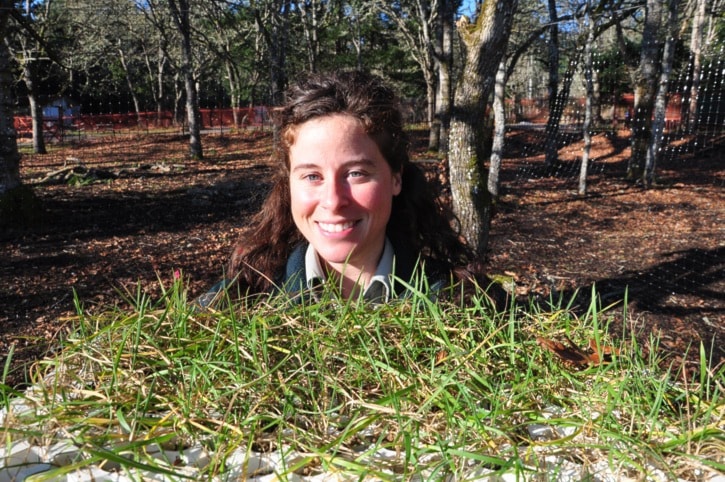Fort Rodd Hill, a site known for its big guns, scenic views and military history, is digging deeper into its natural history.
The fort has covered an acre of manicured lawn inside its front gate under a thick blanket of mulch as part of an experiment to revert the field to a Garry oak meadow and woodland.
The concept is to bring the lawn, amid Garry oak trees, back to a roughly natural state as it might have been 200 years ago. It’s a project that started in 2007 and which could span nearly a decade – the finished meadow isn’t expected to bloom until at least 2015.
“We are hoping by 2015 to have it close to completion, to be restored so it looks like a Garry oak meadow and woodland,” Susan MacIsaac, the Parks Canada species at risk officer at Fort Rodd Hill, who is leading project. “With one acre, visitors can get a good sense of what Garry oak ecosystems are.”
MacIsaac, staff and volunteers started growing camas in 2007, and started a full-fledged plant nursery two years ago with scores of native plants, complete with a tall deer fence. Garry oak ecosystems are flush with plant and animal life, but are considered endangered due to residential development on southern Vancouver Island, and invasive plant species.
Camas itself takes three or four years to get to planting size. It also takes a few years for lawn grasses to die and for invasive species to be weeded out before native wildflowers, shrubs and grasses take root.
Parks Canada staff and volunteers have laboured for years to remove invasive species from Garry oak forests around the historic site, but MacIsaac says nurturing a full ecosystem is their biggest project yet. The meadow won’t be completely back to it’s natural state – MacIsaac plans to erect a tall deer fence around the area.
“We think this is what would exist there naturally. What is great about this national historic site is the military preserved a lot of the ecosystem because it camouflaged the area,” she said.
“Fort Rodd Hill wanted to blend in. It didn’t want to take too much down.”
The next steps are designing a landscape plan for trails and signs for the various ecological attributes of the meadow. “There is a lot of preparation before we get planting anything. The project will be beautiful when it’s completed,” MacIsaac said. “It will be another great opportunity for visitors to enjoy Fort Rodd Hill.”
Fort restoration
While staff help create an Garry oak ecological niche, others are drawing up plans to help restore the aging and salt-eaten battlements that make up Fort Rodd Hill.
Fort Rodd Hill is considered one of the best preserved coastal artillery sites in North America, but manager Dave King said keeping ahead of repairs is a tough business. The Parks Canada staff are drawing up a repair management plan this year for the batteries and barracks.
The upper and lower batteries in particular – the reenforced concrete structure that defines the fort – are slowly breaking apart from the inside. Salt air rusts internal steel beams causing expansion called “hydraulic jacking.”
King said Parks Canada has a group of experts in historical building restoration and ferro-concrete restoration, but probing into the batteries is fraught with risk. Once you start drilling holes, there is no going back.
“You have to know what you are doing before you make a hole in a historical building, you’ve got to proceed cautiously,” King said. “If you replace a roof, is it still a historical building? It’s a challenge to retail the original historical fabric while maintaining the integrity of the building. It’s a balancing act.
“We have a no-harm rule. We want to do the minimum amount of damage possible,” he continued. “But if you look at the world, this place is in really good shape. We’re lucky in Victoria there is no freeze and thaw.”
All the buildings at Fort Rodd Hill and Fisgard Lighthouse are originals from the 1890s to 1950s, except for the small boathouse. King said the management plan will point them to which structures need priority, and the expected cost for repairs.
“The best way to keep historical buildings in good shape is to use them. It’s worse when you let them fall to neglect,” King said.
